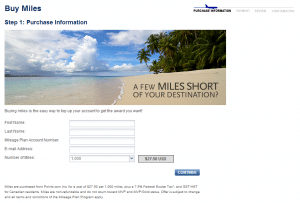Frequent flier miles can be a really amazing tool for seeing the world. I used miles to travel in international business class when I came home from Europe earlier this year, and while it was a bit of an extravagance, I was in a position to do it, so I went for it.
Acquiring frequent flier miles is a hobby that can border on obsession with people. (Um, not me, of course.) And yet, even if your mileage balance is effectively nil, and even if you have no interest in collecting and holding onto miles, you may be able to use them to save money on airfare.
Table of Contents
Get miles
Even if you’re unfamiliar to the travel hacking game, you probably know that you can earn frequent flyer miles when you fly, and that these miles can be used for free travel.
You might also know that there are lots of ways to earn miles, often involving credit cards. In fact, pushing credit cards appears to be a stronger business motivation for the airlines than even flying. (Doubtless you heard the credit card pitch given mid-flight.) Arguably, most people gain more miles by not flying these days, due to high credit card sign up bonuses and incentivized credit card spending.
You can imagine how I feel about that, though.
Buy miles
You can also buy miles outright. There are usually some restrictions on how many you can buy and when, but it is almost always an option.
There are two main reasons to buy miles.
- When you have almost enough for an award ticket. On most airlines, a ticket from the US to Europe costs 60,000 miles. If your mileage balance is, say, 56,254, you may want to spend the $100 or so and purchase the 4,000 miles needed to get you over that threshold.
- When the cost of purchasing miles may be less than the cost of purchasing the flight outright.
It is this last reason that is often very overlooked, which is a shame, because it can be an easy way to save money when traveling, and it doesn’t require any money-laundering schemes or even credit cards. Which appeals to me.
How to know if buying miles is a good deal
Before I go any further, let me state that buying miles usually isn’t a good deal. Or rather, it depends on the type of travel you are interested in.
For example, a domestic saver award ticket on United costs 25,000 miles. To buy that amount of miles on United would cost $940.63. I know that airfare is expensive, but it’s not (yet) that expensive. Unless, of course, you’re traveling around the holidays. Or last minute. In which case, airfare could very much be that expensive.
Also, the calculation gets a little more favorable when you go international or when you purchase business or first class.
To determine if purchasing miles is a good deal, the cost of purchasing the miles plus the cost of redeeming the miles must be less than the cost of the fight.
Or, in equation form, buying miles is a good deal when:

Caveats
There are a few cautions to buying miles for immediate use on a flight.
- You have fewer flight options. While an airline may have many flights a day between city pairs, this doesn’t mean that you can redeem miles on all of those flights. Sometimes you’ll have a few options per day, sometimes you’ll have a single flight option, and sometimes you’ll need to adjust your travel dates to be able to find any flight at all. So you lose a certain amount of flexibility when you purchase miles.
- The flight options can change quickly. Airlines usually allocate a certain number of seats for mileage redemption, and when those seats are filled, no more award redemptions. So just because a flight can be purchased with miles today doesn’t mean that you will be able to do this tomorrow. Or even later today. If you do purchase miles, you’ll want to be ready to redeem them right away, though even then, it’s not 100% guaranteed.
- You still need to pay taxes on the redeemed flight. If you’ve never redeemed miles, you may think that when you redeem miles, the flight is free. Alas, you have to pay taxes on the flight, which can vary widely, usually from $20 to $200. In addition, some airlines charge “fuel surcharges” which can run to many hundreds of dollars. So your free flight, if you’re not careful, can be quite expensive.
These are just cautions though, and with due diligence they are unlikely to affect you, but they are important to keep in mind.
How much will it cost?
Here is a list of some of the major US airlines and their cost for 1,000 miles:
[table width=”500″]
Airline, Cost per 1000 miles (not including taxes)
Alaska, $27.50
American, $29.50
Delta, $35.00
Frontier, $26.80
United, $37.60
US Airways, $35.00
[/table]

Note that most of these airlines will charge a 7.5% tax, and some will ding you with a “processing charge” as well. At the same time, some of these airlines, especially US Airways, routinely have sales that can dramatically reduce the cost of buying miles.
Also, the information above is very subject to change. Airlines change these charts all the time, and have full power to change their program whenever they want. Miles could double in price tomorrow, and also be worth half as much.
But this is actually an argument for buying miles, at least when compared to the slow accruing of miles (like I’ve historically done). If you’ve been saving patiently for a 25,000 mile ticket and then the price suddenly jumps to 50,000, there’s nothing you’ll be able to do about that.
So consider purchasing miles for your next trip as a way to get you from here to there. And if you find a sweet deal, jump on it!
But enough about me. Have you ever bought miles?


